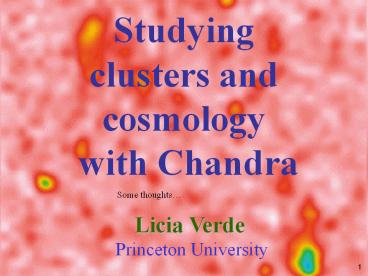Studying clusters and cosmology with Chandra PowerPoint PPT Presentation
1 / 20
Title: Studying clusters and cosmology with Chandra
1
Studying clusters and cosmology with Chandra
Some thoughts
Licia Verde Princeton University
2
Overview
- The potential of combining
- X-rays optical CMB..
- Clusters scaling relations with X-rays and
- the Sunyaev-Zeldovich effect
- constraining dark energy (Quintessence)
- Conclusions
3
Coordinated Cluster Measurements
- Optical
- Redshift velocity dispersion
- Photometry and lensing
Galaxy Cluster
- mm-Wave
- SZ Compton Scattering
Cosmic Microwave Background
chandra
- X-ray Flux
- Temperature and luminosity probe mass
HOT Electrons
4
SZ Signature
Hot electron gas imposes a unique spectral
signature
145 GHz decrement
220 GHz null
270 GHz increment
1.4x 1.4
Easy to find!
NO SZ Contribution in Central Band
5
Clusters as Cosmological Probes
- Multiple uses
- Standard candles
- Standard rulers
- Probes of volume
- Probes of velocity field
- Probes of initial conditions
- Multiple observables
- Clusters counts ()
- SZ luminosity
- Central SZ decrement
- X-ray temperature ()
- X-ray luminosity()
- Angular size()
- Velocity Dispersion
- Redshift
- Lensing Mass
- Kinetic SZ amplitude
- Amplitude of fluctuations
- Scaling relations
- Gravitational lensing of CMB gives F
- Kinetic SZ gives v2
- Cluster counts give
- N(M,z)
- N(FSZ,z)
Need to know cluster physics
Linked theoretical/observational effort
essential for using these observables as
cosmological probes.
6
Clusters scaling relations
(e.g., size temperature, mass-temperature)
(Verde et al. 2000)
Mohr et al 1997, Mohr et al 2000
7
New scaling relations that include the SZ
decrement
(Verde, Haiman, Spergel 2002)
chandra
Observables SZ, angular size,
redshift,Temperature
constraints M-T relation
THSC
Virial relation
Total SZ decrement
8
If our understanding of cluster physics is
correct
Narrow
Clusters should occupy a fundamental plane
9
Modifications in the Position, orientation and
redshift evolution of the plane
Different cluster physics and/or
cosmology
Scaling relations with SZ
(THSC prediction)
narrow
broad
10
Formation redshift?
Mathiessen 2001 finds no evidence for zf being
relevant to clusters properties
Only formation redshift
Only stochastic
11
300 clusters with follow up
Assume cosmology, study cluster physics ?
fM Lacey Cole 94 parameter for the formation
redshift distribution
2D KS test
12
Back to
Observations e.g., Xu et al. 2001, Mohr, Evrard
1997, Mohr et al 1999
Effect of formation redshift
Can constrain a fiducial model
Deviations from virialization parameterized by
For a fiducial model
13
Assume cluster physics, study cosmology
Assume formation redshift distribution is
important Constraints from
Used KS, Lokelihood is much more sensitive
14
MAP 2 yr
Cluster abundance
15
ADD information about dN/dz (mass function)
With Z. Haiman
Break the cluster physics/cosmology degeneracy
16
- Shown a taste of the many possibilites
- The fundamental plane/scaling relations approach
can be - generalized to include other observables such
as - velocity dispersion, X-ray luminosity, shear,
- central SZ decrement.
- Used KS test, likelihood is much more sensitive
- Insensitive to the mass function and independent
from it - Can be used in tandem with dN/dz (clusters
counts) to - lift degeneracies between cosmology and cluster
physics - Important to constrain clusters physics (fixed
cosmology)
17
Dark energy ?
Verde et al 2002
deBernardis et al. 2001
Perlmutter et al. 1998
From Verde et al. 2002
Nature? Equation of state?
18
s
MAP will constrain
and cosmological parameters
8
The growth of structure (i.e. cluster abundance
evolution)
Nature of dark energy
Haiman et al. 2000
(once we know clusters physics)
19
Conclusions
- X-ray CMB optical theory
- Clusters scaling relations with SZ (Tx)
- (study cluster physics and cosmology)
- constrain dark energy exploiting
- growth rate of structure
20
END

